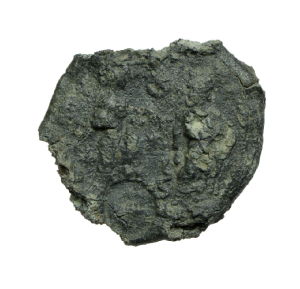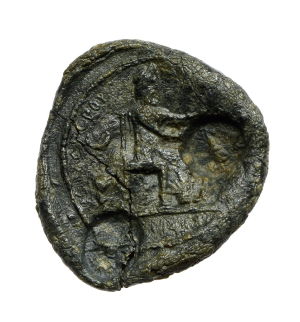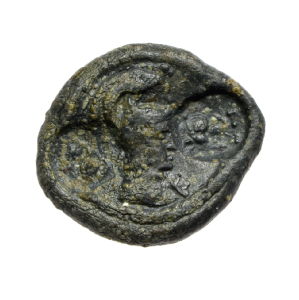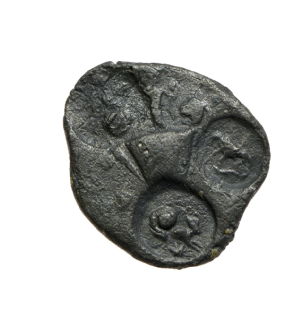All entries for Saturday 01 June 2019
June 01, 2019
Countermarks on Athenian Tokens
Athens is the city in the Classical world that minted tokens on a scale previously unparalleled, only to be superseded by Rome. Tokens in Athens had a continuous life of about seven centuries and facilitated numerous aspects of public life: the functioning of the Council, the Courts, the Assembly, participation in the Dionysia, the Panathenaea and the other festivals.
Researchers have commented on the relations between tokens and coins and have asked to what extent coins functioned as an archetype for tokens. The answer is clearly negative. Classical tokens do not resemble coins and functioned in an altogether different manner. They were probably used for the selection procedure of citizens who would fill offices and serve as public functionaries, and consecutively for the allotment of citizens to offices and even ‘workplaces’.
 |
|
1.) Agora Museum IL1463.
Alpha with countermark of winged
caduceus, 31 mm.
|
Tokens with letters signify the allotment, the fact that citizens would be allotted randomly to offices (fig. 1). And here is a seeming similitude to coins: there exist letter tokens which are countermarked. But contrary to coins, where countermarking meant the revalidation of the item, so that issues were put afresh into circulation, the countermarking in this case signifies the particular sector of public life and complements the token design. Flans are particularly wide, probably because the placement of the countermark was conceived from the beginning. The designs of the countermarks – the winged caduceus (fig. 1), the kernos and the amphora in an ivy-wreath – are well attested in categories of official artefacts and they qualify as designs of the state seal (sphragis demosia). The exact offices they represent can only be conjectured but they can be seen as analogous to the stamps on the juror’s allotment plates; here the ‘owl in wreath’ stamp meant that the citizen was eligible for jury allotments and the ‘Gorgoneion’ stamp meant magisterial allotments.
It seems that the solution of the countermark was short-lived because only three out of the approximately three hundred Hellenistic tokens excavated in the Athenian Agora have a countermark placed next to a letter type.
Contrary to the rarity of countermarks on tokens dated to before Sulla’s sack of the city (86 BC), which practically marks the end of the city’s independence, countermarks are far more common in Athens of the Roman Imperial Period (fig. 2). In particular more than 200 specimens demonstrate at least one countermark out of the 620 tokens that can be securely dated to the period between the first century AD and AD 268, when the destruction inflicted on the city by the Herules marked the end of token use in Athens. It is worth noting that most of the tokens in strata and deposits containing Herulian debris carry countermarks. Our attention is particularly attracted by the countermarks of ‘snail and rabbit’ and ‘stork holding lizard by the tail’, which are the most abundantly attested. In the trench containing dumped fill as a result of clean-up operations after the Herulian sack, countermarked tokens co-exist with un-countermarked specimens, albeit they are found on the same types. These mainly celebrate the cults of Asklepios, Hygieia and Telesphoros (fig. 3) or Asklepios alone, Dionysos (fig. 4), Serapis, Zeus and Nike, Athena and Nike and also Themistocles, and the Minotaur, alone or with Theseus. The latter cases may be related to the claims of Athenian elite families for status and prestigious ancestry.
 |
|
2.) Selection of tokens excavated in and around the Attalos Stoa,
Athenian Agora (Archives of the American School of Classical
Studies 2012.25.0091).
|
 |
 |
The same pattern is also encountered on the tokens found in piles on the floors of the Attalos Stoa and also in the immediate vicinity of the Attalos Stoa to the south.
 |
Specimens are also quite often found to have been countermarked twice by the same stamp, such as the token with an Athena bust and two countermarks of the snail and rabbit type (fig. 5). More puzzling are the Herakles and tripod tokens, which on their reverse side bear three distinct countermarks: stork and lizard, snail and rabbit, and a third design not easily identifiable (fig. 6).
Both the designs of stork and lizard and of snail and rabbit relate to universal symbols and refer to narratives that could be easily adapted as badges and emblems. The stork in particular was very popular in medieval heraldry.
The meaning of the countermarks is not easy to decode. The countermarked tokens capture only a moment in the history of Athens, because they represent the types and specimens that were in circulation at the time of the Herulian Invasion and their preservation may be thought random. Even the hoarding of countermarked pieces together with un-countermarked specimens may have been occasioned by the circumstances that prevailed shortly after the destruction. The interpretation of the countermarks is all the more hindered by the scarcity of tokens in the centuries from the Augustan Period to the mid-third century AD, which could serve as a point of comparison.
Margaret Crosby suggested that the same countermark on varying types might help to identify the same authority behind the issuing of the tokens. The purpose of these tokens would have been admissions to games and festivals, such as those referred to in inscriptions of the third century AD. In fact the legend on two of the types reads ‘of the Gerusia’, the council formed by notable Athenians and instituted by the emperor Commodus in the year AD 178/9, which had the agonothesia of festivals. The Attalos Stoa was thought to provide an advantageous view of spectacles and processions going along the Panathenaic Way and in view of this function, tokens excavated there seem to come as no surprise.
It is well known that the holding of offices in the Hellenistic and increasingly in the Imperial period involved considerable private expense. The iconography of the countermarks and even some of the token types might then be related to wealthy gerusiastai and office-holders in general, who competed for the recognition of the people, an idea already advocated by Margaret Crosby.
 |
Along these lines, the countermarking a second or even a third time of tickets is to be considered as a renewal of their otherwise short lifetime. Roman period tokens were literary ‘time stamped’ and given out for a second or a third use since all the festivals were naturally recurring events. The registration of singular events constitutes the very essence of tokens across time, not unlike the modern-day block chain and its digital database or ledger.
This month's entry was written by Mairi Gkikaki. This blog forms part of the Project 'Tokens and their Cultural Biography in Athens from the Classical Age to the End of Antiquity', a Marie Skłodowska-Curie Action, which has received funding from the European Research Council (ERC) under the European Union's Horizon 2020 research and innovation programme under grant agreement No 794080-2.
Bibliography:
W. Bubelis, ‘Tokens and imitation in ancient Athens’, Marburger Beiträge zur Antiken Handels-, Wirtschafts-, und Sozialgeschichte 28 (2010), 171-195.
E. Curtius, Über Wappenstil und Wappengebrauch im klassischen Altertum (Berlin, 1874).
M. Crosby, ‘Lead and Clay Tokens’, in M. Lang and M. Crosby, Weights, Measures and Tokens. The Athenian Agora, vol. 10 (Princeton, 1964), 69-146.
D.J. Gaegan, The Athenian Constitution after Sulla, Hesperia Supplements 12 (Princeton, 1967).
M. Gkikaki, 'Tokens in the Athenian Agora in the Third Century AD: Adverstising Prestige and Civic Identity in Roman Athens', in A. Crisà, M. Gkikaki, and C. Rowan, Tokens: Cultures, Connections, Communities (London: Royal Numismatic Society, forthcoming)
S. Killen, Parasema. Offizielle Symbole griechischer Poleis und Bundesstaaten (Wiesbaden, 2017).
J.H. Kroll, Athenian Bronze Allotment Plates (Cambridge, 1972).
J.H. Kroll, ‘The Athenian imperials: results of recent study’, in J. Nollé, B. Overbeck and P. Weiss (eds), Internationales Kolloquium zur Kaiserzeitlichen Münzprägung Kleinasiens. 27-30 April 1994 in der Staatlichen Münzsammlung (München, 1997). 61-9.
M. Lang, ‘Allotment by tokens’, Historia: Zeitschrift für Alte Geschichte 8, 1959, 80-9.
B. Maurer, ‘The Politics of Token Economics’, in. A. Crisà, M. Gkikaki, and C. Rowan, Tokens: Cultures, Connections, Communities (London: Royal Numismatic Society, forthcoming).
K.D. Mylonas, ‘Αττικά Μολύβδινα Σύμβολα’, ArchEph 40, 1901, 119-22.
J.H. Oliver, The Sacred Gerusia. The American Excavations in the Athenian Agora. Hesperia Suppl. 6 (Princeton, 1941).
P.J. Rhodes, A Commentary on the Aristotelian Athenaion Politeia (Oxford, 1981).
G.C. Rothery, Concise Encyclopedia of Heraldry (London ,1994, reprint of the book first published in 1914).
H.A. Thompson and R.E. Wycherley, The Agora of Athens: The History, Shape and Uses of an Ancient City Centre, The Agora of Athens, volume 14 (Princeton, 1972).
P. Tselekas, ‘Countermarks on the Hellenistic Coinages of Lesbos’, in P. Tselekas (ed), Coins in the Aegean Islands. Proceedings of the Fifth Scientific Meeting 16-19 September 2010, (Athens, 2010), 127-153
O. Van Nijf and R. Alston (eds), Political Culture in the Greek City after the Classical Age (Leuven, 2011)
 Clare Rowan
Clare Rowan

 Please wait - comments are loading
Please wait - comments are loading

 Loading…
Loading…